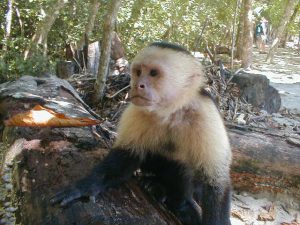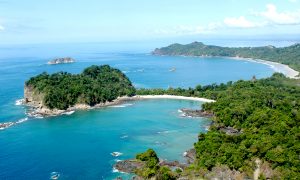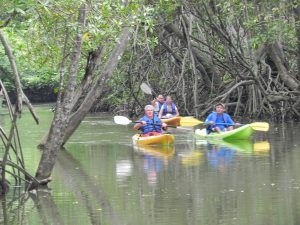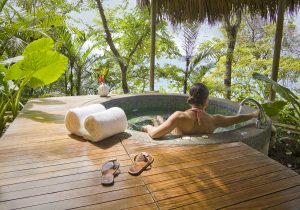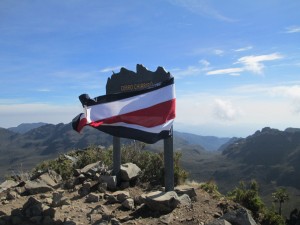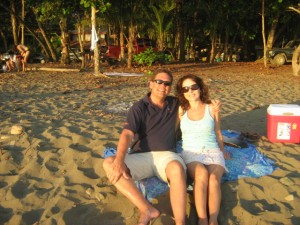This post is the lead-in to a series I plan to do on Manuel Antonio. This one offers a Manuel Antonio overview, or a Manuel Antonio in a Nutshell…
Wait, It’s Not on the Map?
Manuel Antonio is a tiny strip of tropical terrain that extends out into the Pacific just outside of the town of Quepos, on Costa Rica’s southern Pacific coast. It is located in the province of Puntarenas and in the canton of Aguirre. Costa Rica’s coastal highway, known as the “Costanera”, stretching from Orotina to where it meets up with the Pan American Highway in Palmar Norte, runs right by the outskirts of Quepos. This is a very well-maintained and paved stretch of highway, perhaps one of Costa Rica’s best. So, getting to Manuel Antonio from San Jose, a trip of only about 100 miles, is quite easy and these days takes roughly 2.5 hours. Playa Jaco, another popular tourist beach, is about an hour away to the north. Playa Dominical, a popular beach with surfers and nature enthusiasts, is about a half-hour south. There is also a domestic airport just outside of Quepos, with multiple daily flights from San Jose that are are quick and affordable.
A Few Things You Might Not Know
If you look on the map for Manuel Antonio, you’ll likely only see the little town called Quepos. That’s because Manuel Antonio is really just the name of the small, but wildly popular, national park that sits at the end of the tiny strip mentioned above. People often get confused on this point, but in a sense, Quepos and Manuel Antonio are the same place. However, in many respects, they are vastly different.
Quepos is a small town of around 20,000 inhabitants. The name originates from the indigenous people that inhabited the region during colonial times. Quepos is primarily a fishing village. However, it has grown over the years and now features a marina, as well as many dining, shopping and nightlife options for tourists.
The Park
The big tourism draw in Manuel Antonio is, of course, the national park. The park was created in 1972 and is the smallest, but most popular, of Costa Rica’s national parks. The park encompasses roughly 4,000 acres of land. In comparison, Corcovado National Park contains 104,900 acres. It is home to many of the jungle animals that Costa Rica is famous for. In the park you’re very likely to come across three species of monkeys: the spider, capuchin (white-faced) and howler varieties all live there. You can also see sloths (both two and three-toed), boas, pizotes (in the raccoon family), 100’s of bird species, and many other animals. In the tiny area of the park there are some 109 species of mammals and 184 species of birds. Because of the small area, it’s quite easy to cover many of the hiking trails throughout the park in a day and you’re almost guaranteed to see animals. After all, they don’t have much room to hide! That’s why the park has been such a hit with tourists and has made Manuel Antonio one of the “crown jewels” of Costa Rica tourism.
In addition to nature watching, the park features some gorgeous beaches. The four beaches in the park, Espadilla Sur, Manuel Antonio, Escondito and Playita, are some of the best in the country. At 236 feet in height, Cathedral Point, which lies between Playa Espadilla Sur and Playa Manuel Antonio, provides a panoramic view of the surrounding area and blue ocean waters. In 2011, Manuel Antonio was listed by Forbes as among the world’s 12 most beautiful national parks.
What Else is in Manuel Antonio?
Okay, so we’ve talked about the major attraction, the beautiful national park, but what else? The draw of the park has created one of Costa Rica strongest tourist attractions. As a result, Manuel Antonio has grown by leaps and bounds in a very small space of time and land area. There are now multiple hotels of all ratings, from hostels to 5-star luxury resorts. There are numerous restaurants, bars and discos providing a vibrant nightlife, as well as many funky boutique shops. Street vendors peddling a wide variety of home-made arts and crafts are also a common site. Manuel Antonio has pretty much everything the tourist could want and expect from a Costa Rica beach resort location. Despite the growth, Manuel Antonio has been able to maintain its natural tropical feel. You are very likely to wake up from your hotel room to the sounds of the monkeys playing in the trees just outside.
There are many area attractions as well. From extreme sports like white water rafting on the Naranjo River, to more gentle river cruises around the Damas Island Mangrove Estuary or on the Rio Savegre. There are several popular canopy tours in the area. Other popular tours include snorkeling, ATV, waterfall hikes, horseback rides, local culture tours, etc. The national park can be experienced with an organized tour, or you can just go on your own. Naturalist guides can be hired for a modest sum at the park entrance. It always pays to trek through the park at least once with a guide, as they can show you things you’d never know were there on your own. Manuel Antonio is a Costa Rica natural playground with a touch of the high class, which is why the tourists keep flocking there year after year in increasing numbers.
The Future Outlook
Manuel Antonio has changed over the years, but in many ways it retains its earlier remote tropical ambiance. In recent years developers have moved in and have begun to carve up the landscape with private enclaves for the wealthy. The small amount of developable area requires that development be relatively dense, compared to areas like Dominical to the south.
Manuel Antonio has become one of Costa Rica most upscale resort areas, more-so than nearby Jaco or Dominical. It is probably not the preferred destination for tourists wanting to do Costa Rica on the cheap. Where will this growth lead Manuel Antonio in the future?
One thing’s for sure, if your talking about the “tiny strip”, as I’ve referred to it a couple times above, there’s just not much room for a lot more development and growth, unless it goes upwards and becomes even more dense. That type of development will likely be met with fierce local opposition. Proponents of continued growth will have to play a delicate balancing game between development and retaining the natural wonders that attract people to the area in the first place. Much of the growth will likely have to go towards Quepos and the surrounding area, as a result of the fact that there’s more room to grow in that direction.
I’ll conclude this piece on Manuel Antonio in a Nutshell with this thought…
